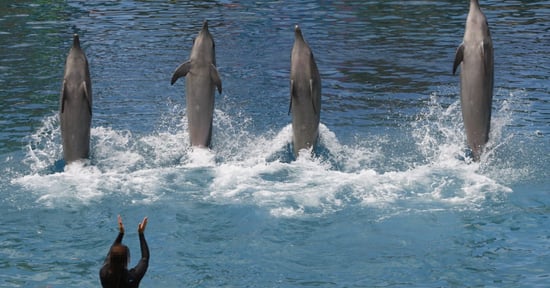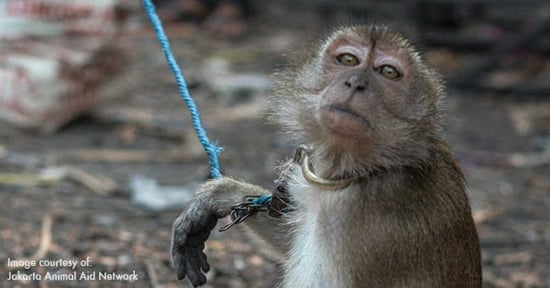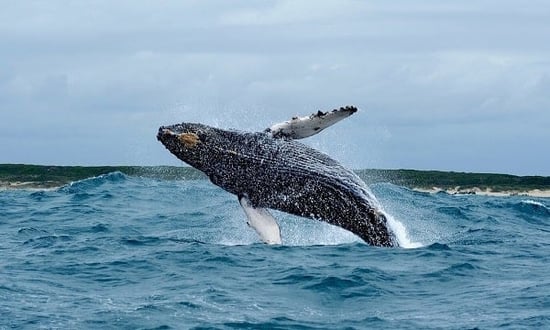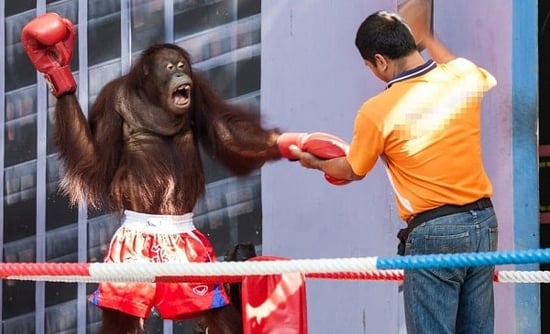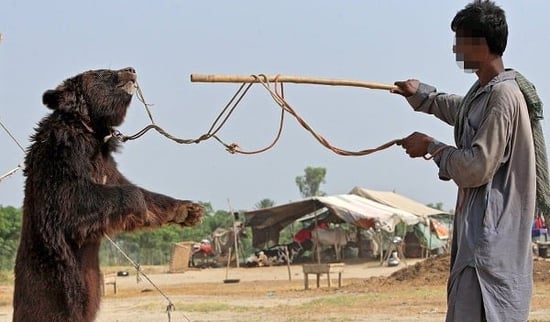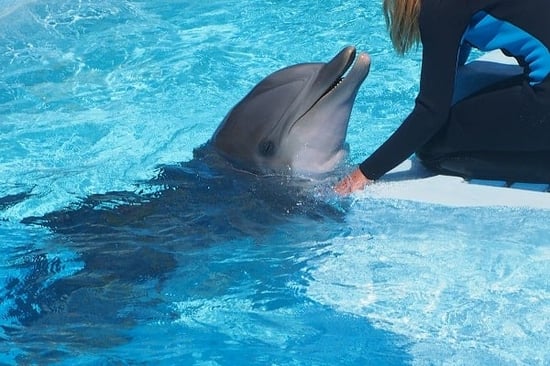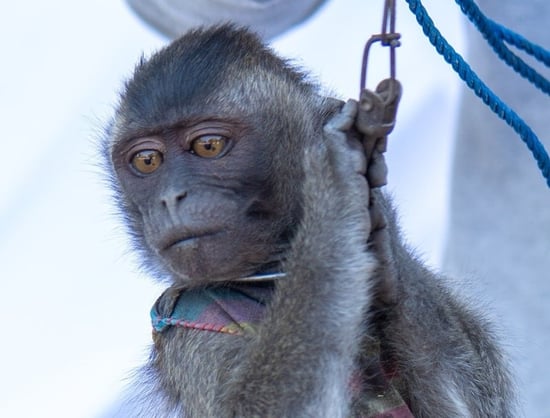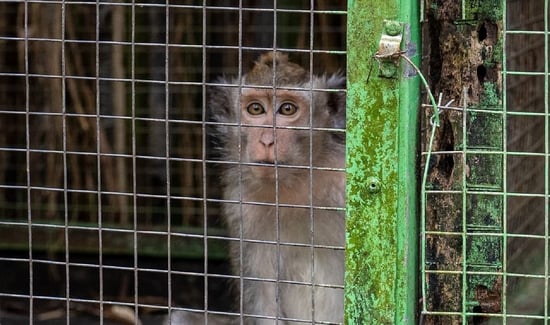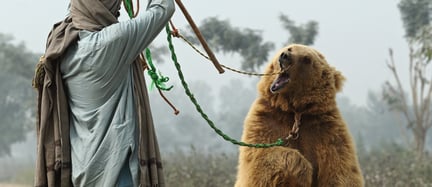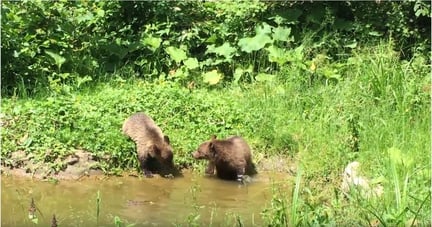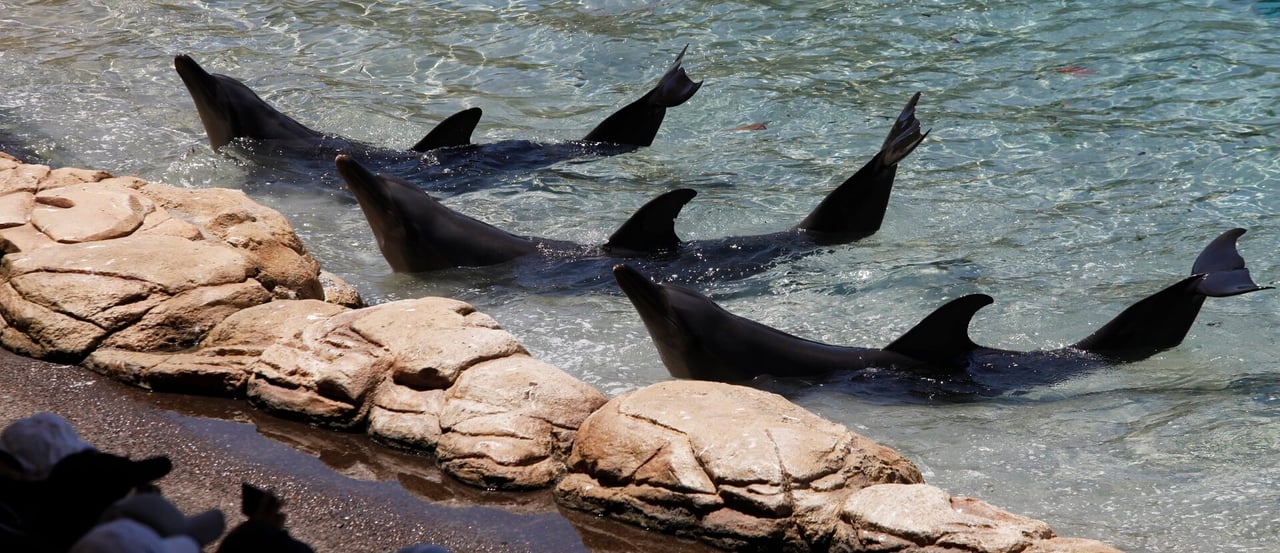
The cruel show must not go on
Header image: World Animal Protection / Dean Sewell
Around 550,000 wild animals are presently undergoing intense physical and mental trauma in the name of tourist entertainment worldwide.
Iconic wild animals such as dolphins, orangutans, bears and many more are being severely exploited for distressing performances to entertain tourists and visitors.
For most of these wild animals, the trauma begins shortly after birth when they’re stolen from their mothers in the most horrific of manners. After that, their spirit is completely broken through cruel ‘training’ regimes, and they are brutally beaten into submission, all just to cater to the growing demand for wildlife tourism.
The increasing demand from tourists and visitors is causing wild animals to be sentenced to a life of dismal captivity. While tourists remain unaware of the abuse going on behind the scenes, the animals trapped in the wildlife tourism industry suffer every day of their lives.
To avoid financing the suffering of wild animals, it is important to do your research before visiting a venue that houses wildlife and make sure any wildlife venue you visit is a genuine sanctuary. For example, it is not a high-welfare venue if it allows direct contact with its animals. And if you can hug, hold, or take a selfie with a wild animal, be sure that extreme cruelty is involved.
Be sure to tell your friends about the truth behind wildlife attractions so they can make better choices for animals while on holiday too.
Together, we can change the world for wild animals and give them a life worth living.
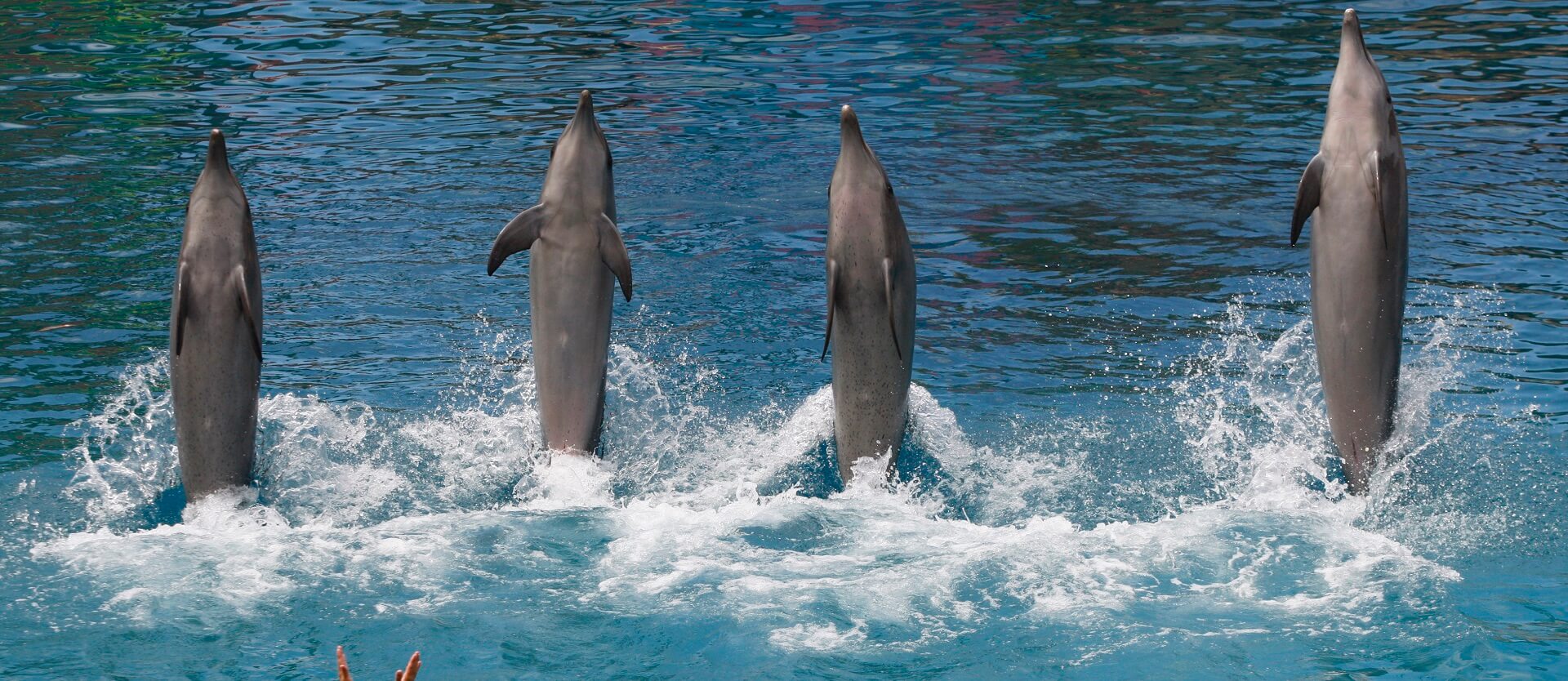
Dolphins
Image credit: Dean Sewell / World Animal Protection
Dolphins: the hidden cruelty masked by a smile
Dolphins are playful, sociable, and highly intelligent animals. Each dolphin has a unique whistle which helps them recognise each other. However, the global tourism industry traps these sentient beings in small, chlorinated tanks, where they undergo severe psychological distress – just so they can entertain tourists.
Around the world, more than 3,000 dolphins, whales and porpoises, are exploited as entertainers to perform activities such as ‘swimming with dolphins.’ And although their appearance may trick you into thinking they are happy, dolphins in captivity have nothing to smile about – it is simply the way their jaws are shaped.
A dolphin may live up to 50 painful years in captivity, which is no life for these endangered wild animals. In the ocean, dolphins swim a distance of about 100 square kilometres and dive to depths of up to 55 metres to forage for their favourite foods, but a captive dolphin has only a fraction of that space to swim in.
Our research shows, more than 60% of all captive dolphins worldwide are kept in China, Japan, the USA, Mexico, and Russia, with the regions of Mexico, the Caribbean, the Bahamas, and Bermuda accounting for almost one in five captive dolphins.
However, a better life for dolphins is possible, and together, we can make it happen. As part of a global movement towards better treatment of these wild animals, major travel brands including TripAdvisor and Booking.com have already committed to stop selling tickets to dolphin shows and encounters, while Canada has passed a ban on keeping dolphins, whales, and porpoises for entertainment, and France has banned the captive breeding of dolphins.
Together, we can make this the last generation of dolphins in captivity and continue putting pressure on the tourism industry until the last tank is empty.
Behind the smile
Read our 'Behind the Smile' report and learn more about the multi-billion dollar dolphin entertainment industry.

Taiji dolphins hunted for tourism
Banner image: Kunito Seko
Every year from September to March, pods of dolphins and other small whales are driven by dolphin hunters into a cove near the village of Taiji in Japan. The hunters bang metal poles in the water to frighten and confuses the pods. Once they are trapped in the cove, the dolphins are sorted into those that will be sold into a lifetime in captivity at theme parks, aquariums and dolphin venues around the world. And those dolphins that will be slaughtered for their meat – turning the water in the cove red with their blood.
Why are dolphins slaughtered in Taiji?
The Taiji dolphin drive hunts continue because demand for dolphins in captivity continues to be profitable. Over the past decade, approximately 1,500 highly intelligent dolphins and whales have been brutally separated from their families for the entertainment industry. After being ripped from the ocean, these dolphins are kept in unnatural conditions for the remainder of their lives. Without this demand the dolphin hunts would likely end.
How many dolphins are killed in Taiji?
Unlike some other marine species, dolphins are not covered under the International Whaling Commission moratorium on commercial whaling. The Taiji dolphin drive hunts are authorised by the Japan Fisheries Agency to a small group of fishermen. Each year a catch quota is set for the annual dolphin hunt and in 2023/24 the quota was made to destroy the natural lives of 1,824 beautiful dolphins and small whales.
Together with other animal groups and dolphin defenders, we’re working to stop the demand for captive dolphin entertainment. And put an end to the misery in captivity these dolphins suffer.
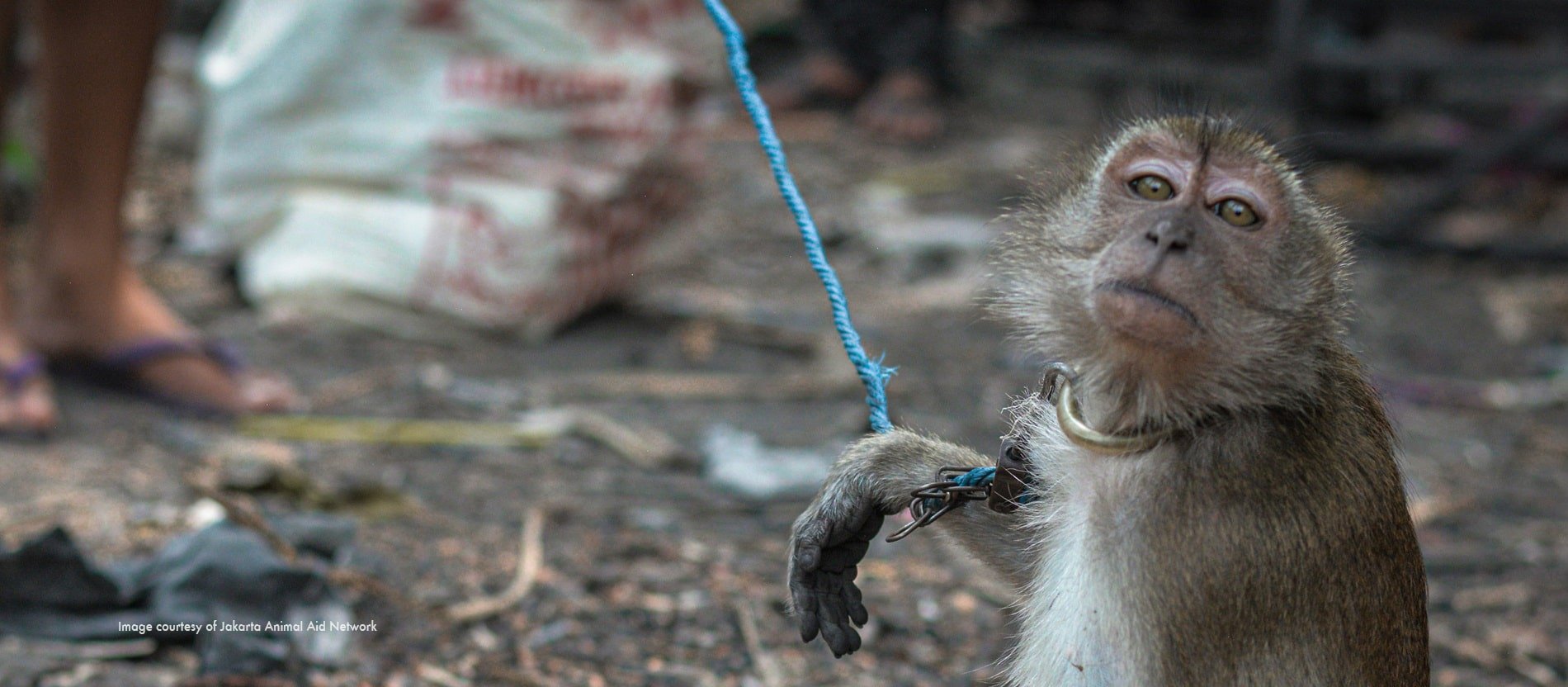
Monkeys
Images courtesy of Jakarta Animal Aid Network
Monkeys are cruelly trained and forced to ‘dance’ in the barbaric ‘Dancing Monkeys’ trade in Indonesia.
Long-tailed macaques are highly social animals who want nothing more than to be able to climb trees, bond with their family groups, and forage for fruits, seeds, and leaves in their natural habitat. Unfortunately, their intelligence and social nature have made them prime targets for abuse in Indonesia’s ‘Dancing Monkeys’ or ‘Topeng Monyet’ trade.
In this trade, young macaques are ripped from their mothers in the wild, who are often killed in the process. They are then subjected to one of the cruellest training regimes imaginable in order to make them perform for tourists and shoppers.
These sentient beings are chained by the neck, beaten, and starved until they obey commands to ‘dance’ or walk on two legs, often while wearing human clothing and doll head masks. When they’re not ‘dancing’, these animals are confined in tiny cages or dark boxes, adding to their misery.
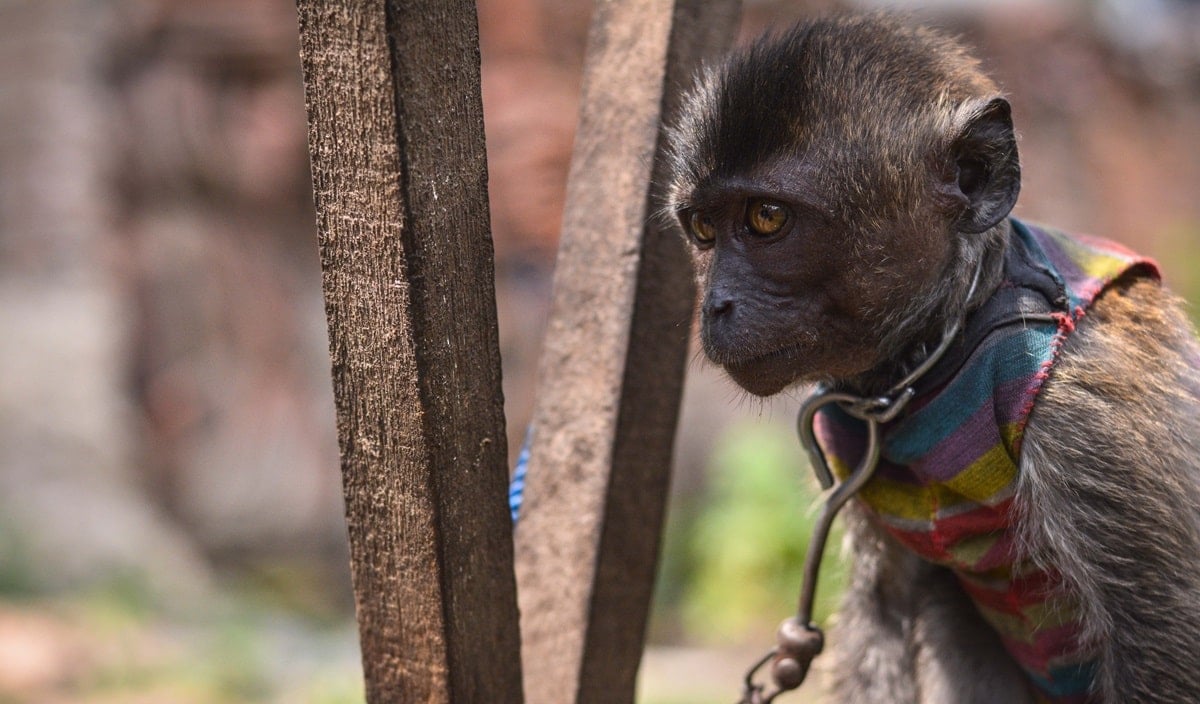 Image courtesy of Jakarta Animal Aid Network
Image courtesy of Jakarta Animal Aid Network
Although this cruel practice was banned by the Indonesian Ministry of Forestry and Environment in 2019, we received information that there was one last remaining monkey dance training centre in Cirebon.
Thanks to our kind-hearted supporters, we were able to partner with Jakarta Animal Aid Network (JAAN) and successfully rescued 31 ‘dancing monkeys’ like Unyil, Momon and Jono from this horrific trade. Now, these sweet animals will finally have a life worth living.
With you by our side, we are also working with the Indonesian government alongside JAAN to ensure former monkey handlers never turn back to this trade, by guiding them towards humane and sustainable alternative livelihoods that don't involve animal exploitation.
Together, we can stamp out this barbaric trade and make this the last generation of ‘dancing monkeys’.
Help monkeys recover from abuse
Will you please help feed and care for 31 traumatised monkeys who were exploited in the ‘Topeng Monyet’ trade for human amusement?
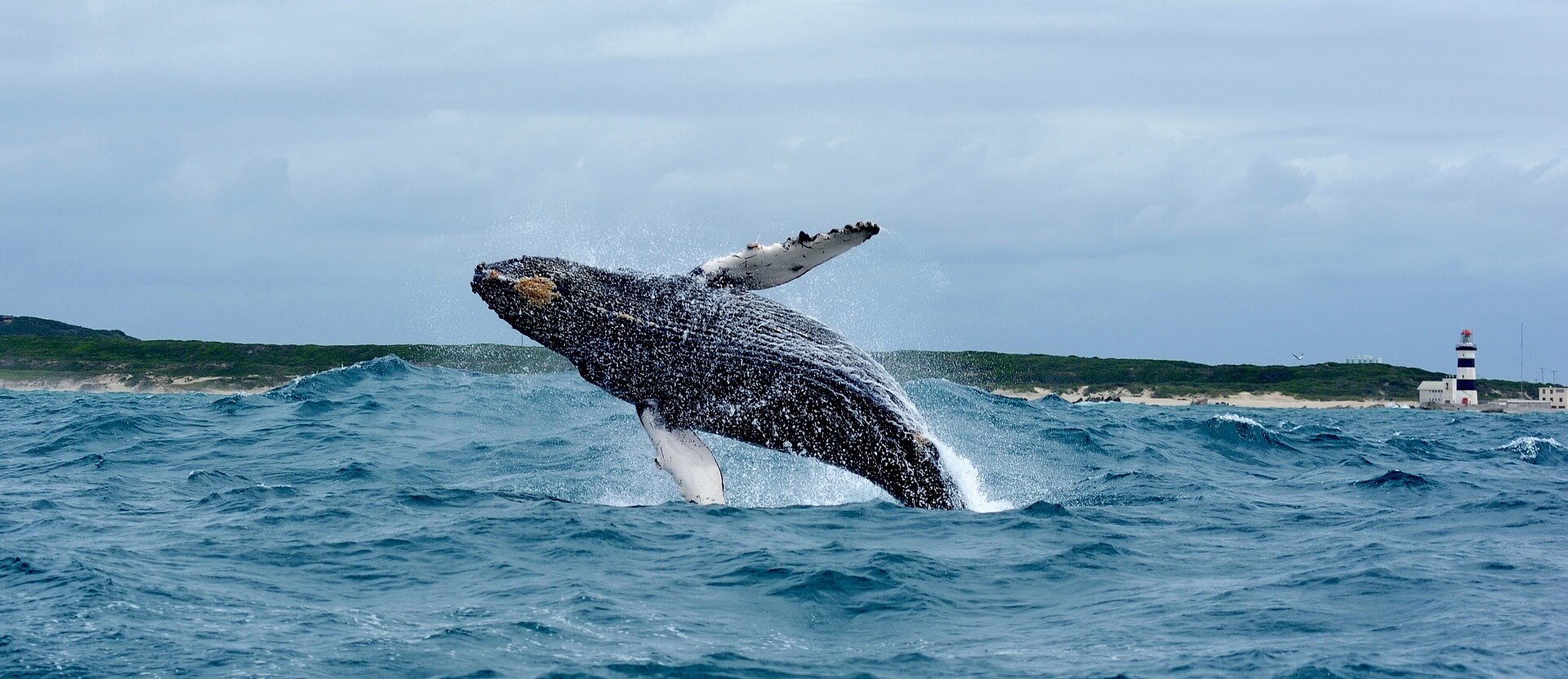
Whale Heritage Sites
Whale Heritage Sites are an ethical tourist option to have meaningful experiences with whales and dolphins
Banner image: Lloyd Edwards / Raggy Charters
Whale Heritage Sites is an initiative that was established by the World Cetacean Alliance and supported by World Animal Protection. It encourages the travel industry to phase out traditional forms of cruel wild animal entertainment like whale and dolphin tricks and shows by offering the industry a path to protect marine wildlife and support sustainable practices.
These sites give tourists and visitors a transparent and easy way to select responsible whale and dolphin watching holiday destinations, encouraging them to experience these beautiful animals in their natural habitat.
People can witness whales, dolphins and other marine wildlife at their best at various recognised destinations around the world. You support can demonstrate the importance of whales and dolphins through culture, education, research, and conservation.
Whale Heritage Sites are open for tourism, and as the travel industry shifts to a wildlife friendly model, more venues are transitioning to meet accreditation requirements and more Whale Heritage Sites will be added to the list.
There are currently five Whale Heritage Sites that you can visit:
- Tenerife-La Gomera marine area in southwest Tenerife, Spain
- Algoa Bay, South Africa
- Hervey Bay, Australia
- Dana Point, California, US
- Bluff, Durban, South Africa
- The Azores, Portugal
- Plettenberg Bay, South Africa
The future is a wildlife-friendly one and together we can make that a reality.
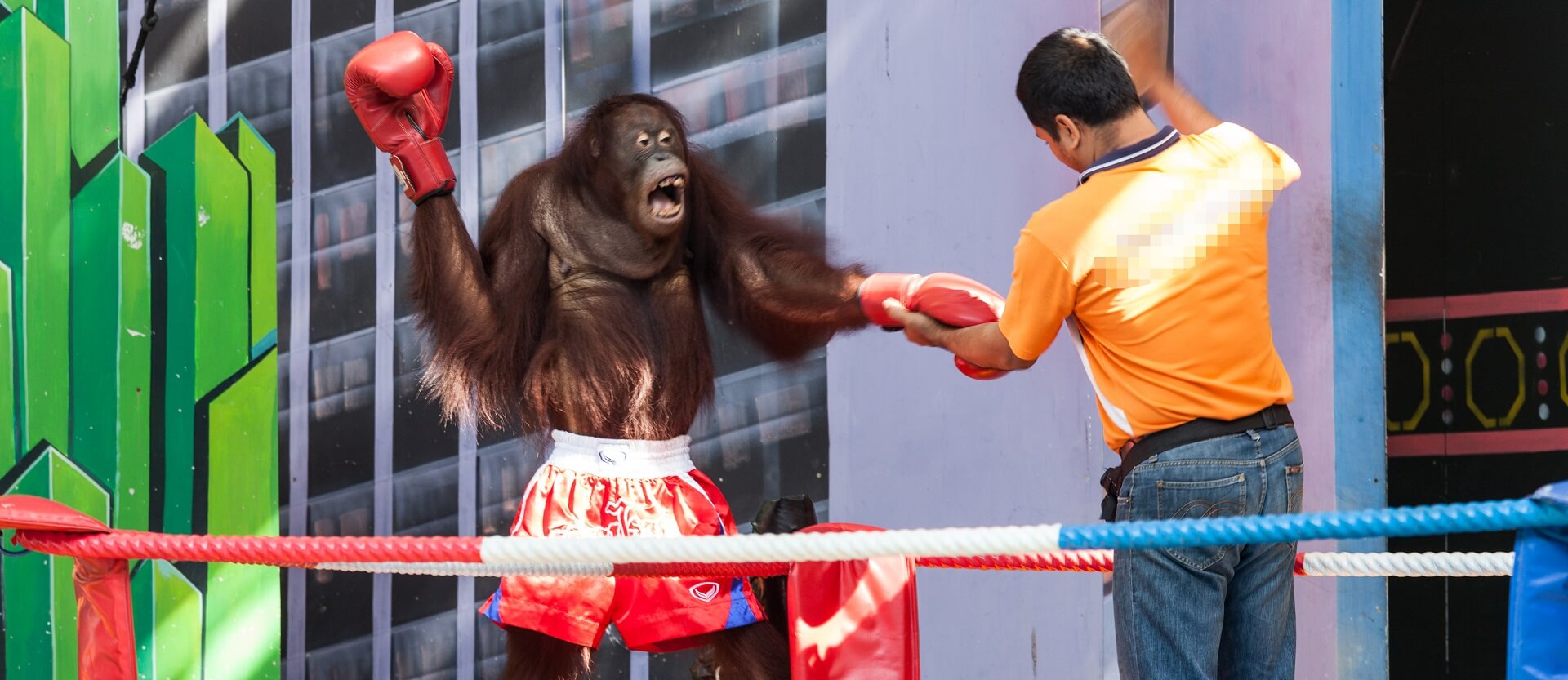
Orangutans
Orangutans are starved, beaten and bullied into putting up shows
Orangutans are highly intelligent and solitary animals who can communicate using gestures and are capable of showing empathy. They tend to have a strong relationship with their mothers in the wild and stay close to them for the first five years of their lives.
However, the wildlife tourism industry treats them as nothing more than profit-making machines when they poach them from their natural habitat. This process often involves killing their protective mothers and snatching them from her arms. All just to cage, beat and starve them so they can perform disturbing shows in wildlife tourism venues.
Orangutan boxing is one such cruel show in which these sentient beings are forced to fight each other in 30-minute-long pretend boxing matches to entertain tourists. Males are often the ones competing in the boxing ring and are made to wear shorts and boxing gloves, while females are made to wear bikinis as they display round numbers.
In addition to this, many wildlife tourism venues offer selfie opportunities and close encounters with them. As a result, distressed orangutans tend to display abnormal behaviours such as repetitive rocking, hair-pulling and regurgitation and reingestion of food as explained in our 2023 Holidays that Harm report.
Forcing wild animals to engage in such unnatural behaviours demeans them as living beings who deserve respect. That’s why it is important for us to realise that a once-in-a-lifetime encounter with a wild animal can mean a lifetime of pain and misery for them.
Together, we can help stop the poaching of orangutans and provide the best care for those previously abused for entertainment.
Holidays that harm
Read our 'Holidays that Harm' report and learn about the wildlife suffering at tourist venues in Bali and Lombok.
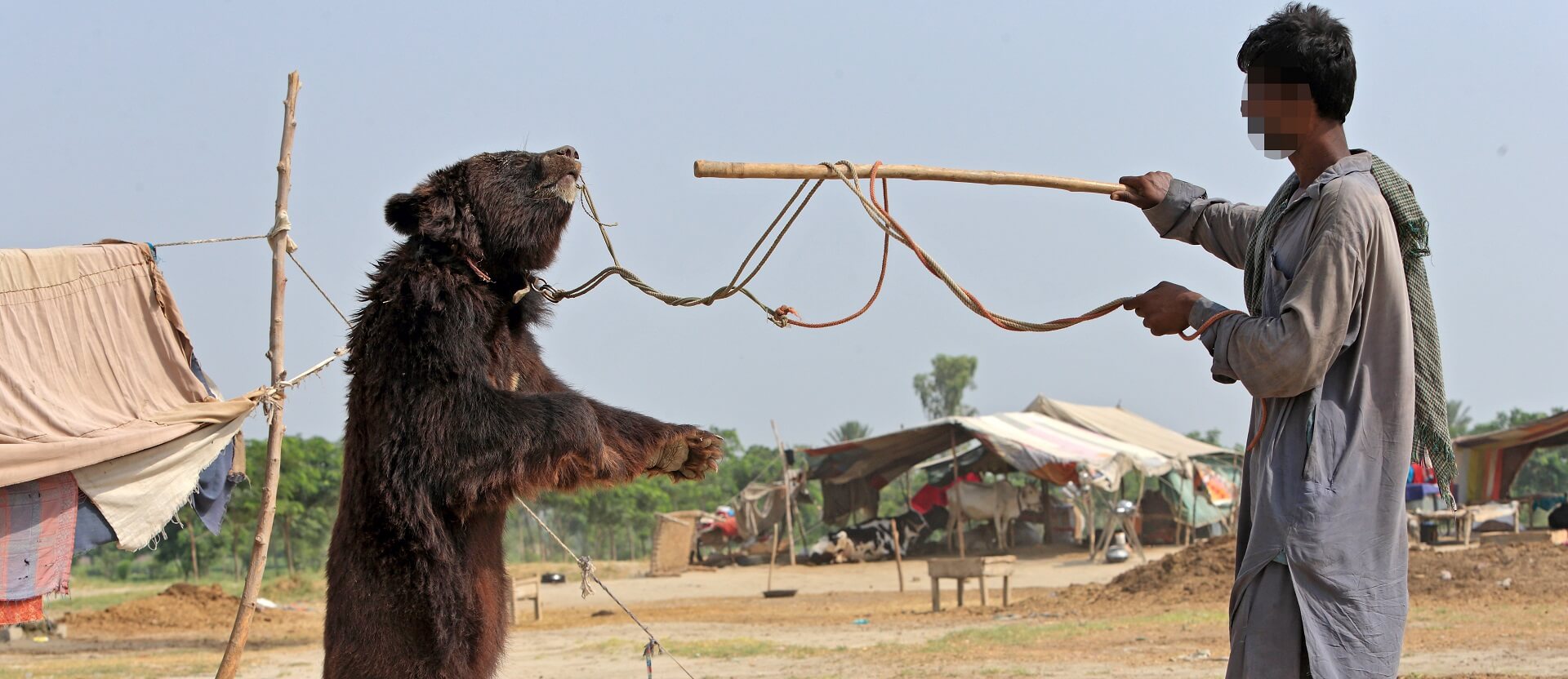
Bears
Bear dancing: a cruel and grotesque spectacle
Image credit: World Animal Protection / Yasir Nisar
Bears are highly intelligent animals who can count, solve problems, and communicate with a range of vocalisations and facial expressions. But unfortunately, they are being inhumanely exploited by the global tourism and entertainment industry in several ways, one of which is bear dancing.
Bear dancing is a form of begging in which a defenceless bear is decorated with ribbons and bells and forced to ‘dance’ on the streets for money. The bears who are made to ‘dance’ are usually trained using horrendous methods and are in a constant state of pain and fear.
The training process of a ‘dancing bear’ involves forcing a bear to step on extremely hot metal sheets where she can only relieve herself from the searing pain by hopping from side to side in a motion that mimics dancing. The bear is then made to repeat this trauma response many times over the sound of music.
Dancing bears endure unimaginable cruelty and suffering on a daily basis. Trained as cubs, their teeth are filed down or knocked out with a hammer, and their claws are often extracted so they don’t pose a danger to their owner.
Their sensitive muzzles are usually pierced with a metal ring attached to a thick, coarse rope. For some bears, the rope is inhumanely threaded directly through their skin – all without anaesthetic.
With your help, we’ve been rescuing bears from the cruel spectacle of bear dancing for over 20 years and have already ended the tradition in Greece, Turkey, India and Nepal, alongside other individuals and organisations.
Together, we can give bears lives worth living and ensure no bear ever suffers such a horrific fate.
Ending bear baiting
We worked to stop bears being cruelly exploited in bear baiting – an inhumane bloodsport where bears, unable to defend themselves, battle against trained dogs for entertainment.
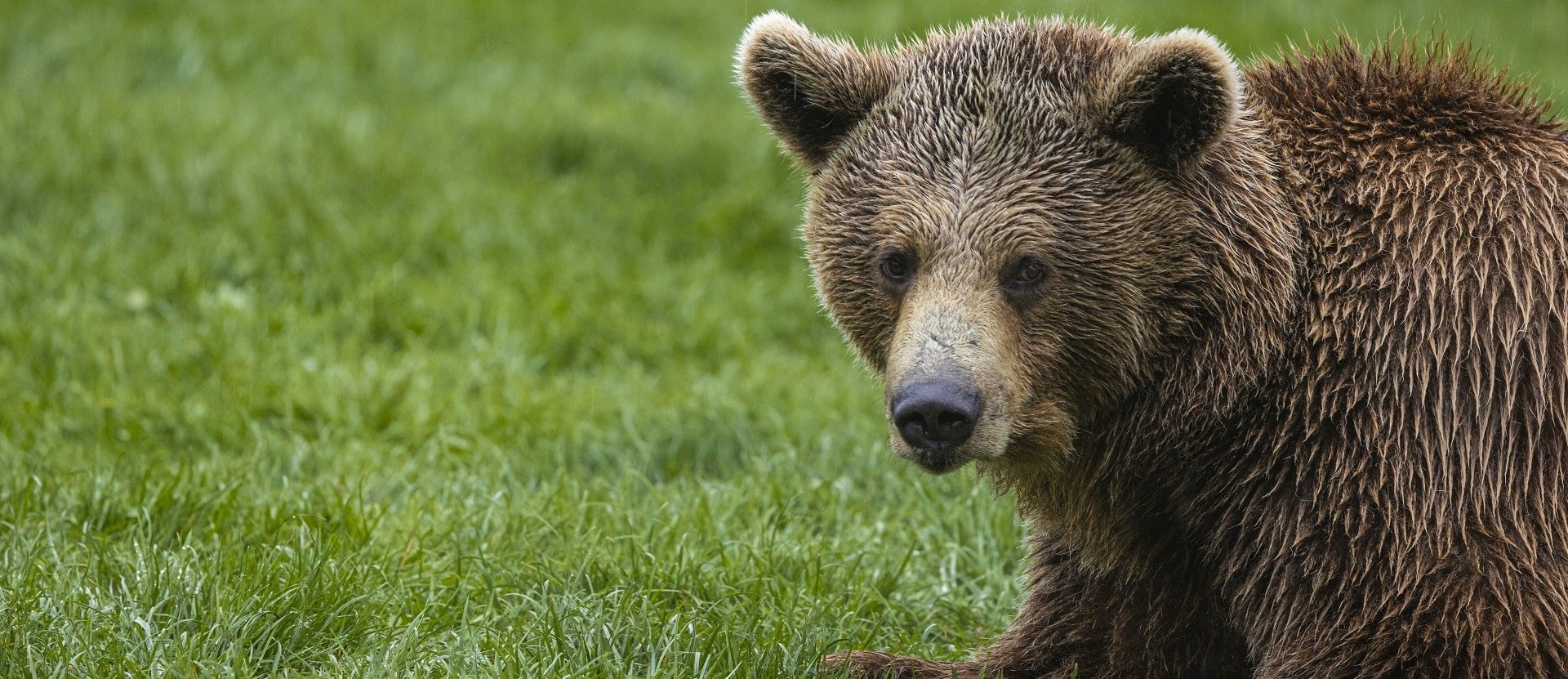
Bear sanctuaries
Balkasar Bear Sanctuary: a safe haven for abused bears
A key area of our work is to save bears who have been abused for entertainment and ensure that they are housed in sanctuaries where they receive the best possible care and treatment. The Balkasar Bear Sanctuary in Pakistan is one such sanctuary where rescued bears can live the rest of their lives in harmony.
With your support, we were able to help our local partner the Bioresource Research Centre (BRC) establish the Balkasar Bear Sanctuary located in the Chakwal District, Punjab, Pakistan in 2010. The sanctuary was created to provide a safe home for bears rescued from cruel forms of entertainment such as ‘bear baiting’ and ‘bear dancing’ with the aim of ending these horrific shows for good.
With over 17 acres (6.8 hectares), the sanctuary houses the endangered species of Asian black bears and Himalayan brown bears. There are two pools, natural climbing structures and denning places that allow the bears to perform all their natural behaviours.
After being exploited and forced to toil for years in the name of entertainment, rescued bears in Pakistan can enjoy a peaceful retirement at this sanctuary.
With your support, we can save bears around the world from a lifetime of cruelty and needless suffering.
Freeing bears from captivity
We worked in Romania to free bears that are being kept in captivity.
